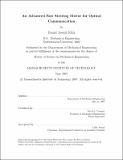An Advanced Fast Steering Mirror for optical communication
Author(s)
Kluk, Daniel Joseph
DownloadFull printable version (24.90Mb)
Alternative title
AFSM for optical communication
Other Contributors
Massachusetts Institute of Technology. Dept. of Mechanical Engineering.
Advisor
David L. Trumper.
Terms of use
Metadata
Show full item recordAbstract
I describe in this thesis the design, fabrication, assembly, and testing of an Advanced Fast Steering Mirror (AFSM) for precision optical platforms. The AFSM consists of a mirror driven in two rotational axes by normal force electromagnetic actuators, and controlled via position feedback loops. The dynamic performance is sufficient to provide high bandwidth (approximately 5 kHz) disturbance rejection of base motion, and as such the device is particularly suited to beam stabilization tasks in laser communication, lidar, and similar optical applications. In fact, work on the Mars Laser Communication Demonstration project at MIT Lincoln Laboratory provided the original impetus for developing the subject technology. My work on this project is divided into five distinct phases: Electromagnetic and mechanical design of the mirror itself; fabrication and assembly of the mechanical hardware; initial testing and dynamic model generation; design and fabrication of an electronic analog controller; and final closed loop performance demonstrations. I performed the first two phases on the MIT campus, and the final three phases at MIT Lincoln Laboratory. Each project phase is described in detail herein. Ultimately, I demonstrate performance from the hardware and control electronics exceeding the original design goal of 5 kHz. As this original prototype is merely a testbed, I also describe possible evolutions of the design to optimize form factor, performance, and flightworthiness.
Description
Thesis (S.M.)--Massachusetts Institute of Technology, Dept. of Mechanical Engineering, 2007. This electronic version was submitted by the student author. The certified thesis is available in the Institute Archives and Special Collections. Includes bibliographical references (p. 241-243).
Date issued
2007Department
Massachusetts Institute of Technology. Department of Mechanical EngineeringPublisher
Massachusetts Institute of Technology
Keywords
Mechanical Engineering.